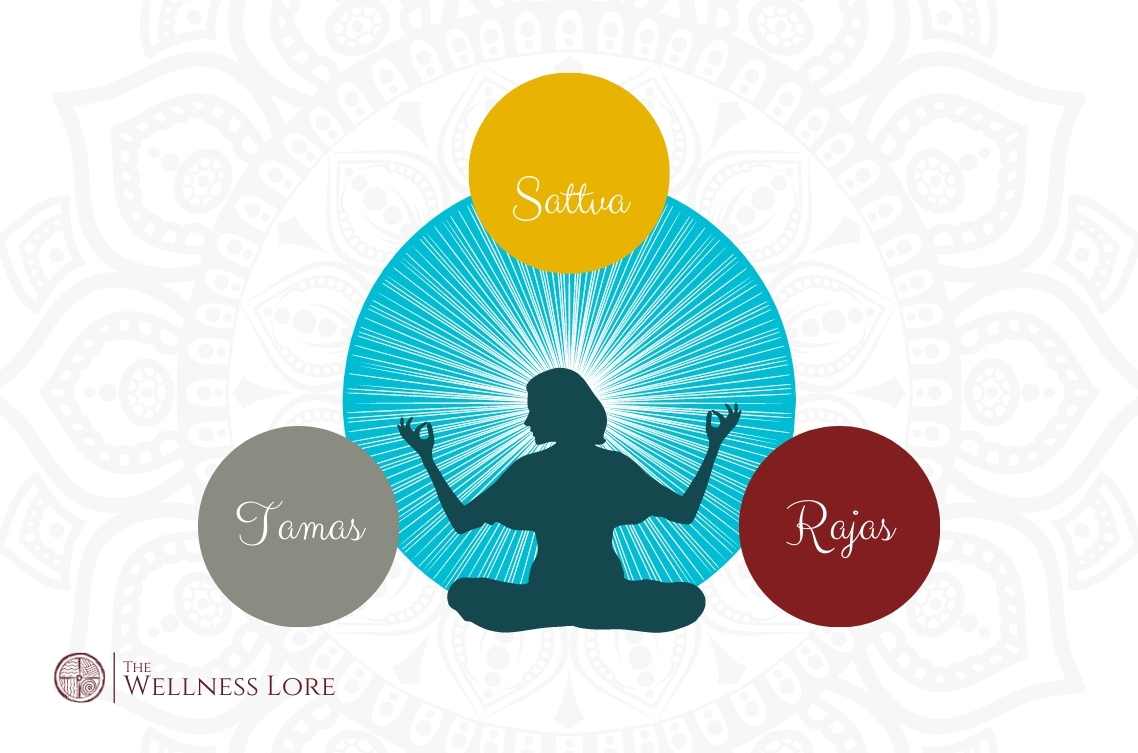The 3 Gunas of yoga and their importance

Yoga is among the few wellness therapies that have generated and enjoyed a sustained buzz for a long time. Several surveys, studies, research, and others have validated the benefits provided by this form of therapy. Within four years, from 2012 to 2016, the number of yoga practitioners in the US alone increased by around 50 percent. Relevant studies have found that people engaged in yoga are much more active in other exercises and sports. The word ‘yoga’ translates to ‘union’ in Sanskrit. The origin of this practice can be traced back 5,000 years to India.
Yoga can help to foster wellness and improve mental, physical, and spiritual well-being. While the exercise does provide several benefits, it can have a unique meaning for each person. However, there has been a consensus that it has the factors necessary to improve flexibility, strength, balance, and stability. Relevant research has also shown that it can help develop healthier eating habits, lose weight, and improve cardiovascular health. Regularly practicing yoga can also help you achieve peace and mental well-being. Some evidence also suggests that the therapy can help patients with chronic diseases with better pain management.
The philosophy of yoga
It is important to note that yoga is a philosophy in itself, and it prioritizes several elements and aspects to promote wellness within each individual. This entire philosophy can be divided into two distinct elements: ‘Prakriti,’ meaning ‘Maya’ or illusion, and ‘Purusha,’ meaning a reality. The core belief within the yoga philosophy is that anything, which can be changed or is not infinite, belongs to Maya. On the other hand, Purusha represents the only unalterable element in life, an individual’s soul or self. The soul is eternal, while Prakriti is an illusion. It is pretty hard to distinguish one from the other. The ultimate goal of yoga is to help individuals rise above illusions and find the actual reality. A person capable of identifying and observing achieves enlightenment.
The gunas
When we think of energy, we often visualize it as mental or physical as the energy that helps us focus on certain things or how we perform various tasks throughout our day. It can be easy to identify when these energies lag within the body. The way forward is to replenish the energy by consuming food, going out, chatting with our close ones, committing to exercise or practice, and discarding harmful habits from your daily schedule.
However, the concept of energy is more complex. Various philosophical schools of thought and ancient traditions, like yoga, teach us that everything in the universe is energy. This claim has been backed up by the teachings of Hinduism, Taoism, Buddhism, and others. Even modern theories have supported this concept. Every object in our life, such as a table, bicycle, or computer, vibrates at a certain speed that helps people see them, touch them, and use them.
Every thought, feeling, or experience consists of a unique energy vibration largely imprinted within your body, taking the form of physical sensations. They are then released, hopefully on the wave of a breath. This non-tangible form of energy can best be understood by delving into gunas. The gunas and their nature, significance, and impacts can be found in the philosophical school of yoga.
The gunas mean qualities in Sanskrit. They are forces of high energy that weave together everything within this universe. In yoga, the three Gunas play a significant role in maintaining health, vitality, and well-being. Gunas can also be considered specific tendencies that influence the response to any situation.
What are the three guns of yoga?
In yoga and within Prakriti, there are three separate gunas, sattva, tamas, and rajas. The word ‘gunas’ means a rope in Sanskrit, and they denote the essential qualities of nature. Three critical attributes make up every creation in this universe. They can be found in the ancient teachings of yoga, such as the Samkhya philosophy and the Bhagavad Gita. These three Gunas represent three distinct characteristics and are present in every person and object. However, it is typically observed that one feature is more predominant than others.
Sattva
In yoga, the sattva symbolizes purity, harmony, and knowledge. It is the principal ingredient in joy, satisfaction, goodness, nobility, generosity, and contentment. This guna is free from violence, fear, wrath, and malice. A person with an abundance of sattva is pure of heart, generous, and forgiving. To achieve enlightenment, people have to increase this particular element within them. One way of growing sattva is by reducing the number of rajas and tamas within the body and mind.
This state can be achieved by consuming sattvic food items, such as fruits, vegetables, legumes, sprouted whole grains, fruit juices, whole grains, and more. Some of the characteristics of these food items are that they are fresh, pure, and usually grow above the ground. These foods receive copious amounts of positive energy through direct sunlight. To elevate the sattvic elements in the body and mind, it is important to regularly practice yoga, follow non-violent principles, interact with positive people, and engage in activities that make one happy.
Examples of sattva in a student and teacher
A sattvic student has mastered at least the first two stages of the seven stages of knowledge, which constitute the main elements of the yoga philosophy. They have developed the capacity to differentiate between the real and unreal, the permanent and temporary features. For a sattvic student, the interest in fleeting things diminishes over time, and they start to share a dispassionate relationship with the unreal.
On the other hand, a sattvic teacher has attained supreme spiritual capacity. This teacher or ‘yogi’ views all living beings on the planet as one and does not teach or believe in hypocrisy. The sattvic teacher remains unaffected by criticism and praise and practices what they preach. A ‘yogi’ represents the sattvic principles and acts as an embodiment of them.
Rajas
Rajas manifest the virtues of passion, energy, action, and motion. This guna is characterized by a strong feeling of attachment, a need, and a desire to achieve satisfaction. Rajas generate activity and keep people active throughout the day. It helps them find purpose in life. Within nature, rajas lead to seeds sprouting, the birth of babies, and other similar phenomena. It can symbolize the energy which inspires change and generates enthusiasm, passion, and self-confidence. However, it is vital to remember that rajas can dominate when we feel agitated with our work or in cases of overexertion. One of the ways to decrease the levels of rajas within the body is to stop consuming certain food items such as spicy dishes, chilies, peppers, onions, caffeine, and various pulses.
Examples of rajas in a student and teacher
A student with an overabundance of rajas needs help seeing the true meaning of spiritual teachings. They have yet to achieve mastery of the first two stages of the seven stages of knowledge. The nature of the relationship they share with their teacher is primarily devotional; in some cases, it can even be fanatical.
The teacher with an overabundance of rajas, or a rajasic teacher, is primarily driven by a need for admiration. These teachers mesmerize and impress their followers through their dress, techniques, and overall personality.
Tamas
Tamas manifests in the form of impurity, laziness, and darkness. It results from ignorance and blocks all living beings from seeing the truth. To lessen the tamasic substances within your body and mind, avoid eating tamasic items such as alcohol, meat, processed foods, etc., or from overindulgence such as consuming too much food, i.e., overeating or oversleeping. This energy is dominant when you feel depressed or experiencing emotional upheaval. When tamas is the predominant force within the body, you might feel disinterested in everything.
Tamas can be balanced by repeatedly lifting your arms over the head, moving to music, or performing a couple of rounds of Sun salutations. You can also engage in chanting or moving meditation practices to focus the mind and remove the effects of tamas. Red meat, garlic, onions, bread, and such food items also lead to an overabundance of tamas within the body. Switching to primarily consuming fruits, vegetables, and whole grains can also lead to balancing the ill effects of tamas.
Examples of tamas in a student and teacher
The primary characteristic of a tamasic student is their ego. They are entirely guided by it and are not inclined to adapt or learn new things. This kind of student fails to discriminate between the permanent and temporary things in life and does not follow any rules or disciplines.
A tamasic teacher indulges in unethical practices and does not follow the rules or regulations. Such a teacher usually adapts his teachings and principles to suit their agenda or motives.
The circle of the three gunas
Despite the three Gunas representing unique characteristics and virtues, all three act on each other and produce several effects. Suppose someone is in a sattvic frame of mind. They are content with their lives and how events are unfolding. They remain present mentally and physically throughout each day. In due course, this state does not last, and this contentment leads to the same person becoming lazy and taking everything for granted. This mindset gives rise to the tamasic elements within the body. These elements can make the person depressed and discontent.
To break through the setting in the tamasic mood, energy generated by the rajasic elements is needed. When a person is pinned down due to the tamasic effects, they start engaging in any activity to get going. They can engage in any activity, one in which they are passionate about or one in which they feel motivated. However, here as well, the dangers of hyperactivity and anxiety prevail. Once the person reaches that state, that state of heightened awareness and activity can lead them to contemplate, meditate, and restore the sattvic state within them. In this state, they enjoy renewed understanding and clarity.
Hence, the journey a person experiences between the sattvic, rajas, and tamasic states is mainly cyclical and often repeated. This phenomenon mirrors the essential nature of life.
How to positively channel the gunas?
The psychological qualities inherent in a human mind can often be highly volatile and fluctuate between the three in a cycle. It is observed that the guna, which is the most predominant, influences the mind and shapes your perceptions. It also helps in developing a specific perspective. For a person in whose mind the characteristics of rajas dominate, they may be highly chaotic, confused, and demanding. These factors influence their decision-making, actions, and response to any event. To move on from this state, a person must focus on self-improvement, deliberation, contemplation, and reflection. It is essential not to react quickly and rise above the ill effects of the rajasic elements. A person should also find the inner strength, willpower, and self-control to shift harmful thoughts and actions away to reduce the impacts of tamas and rajas within the body. It would help in achieving a sattvic quality of life.
Final Summation
Gunas are the tendencies or qualities that deeply affect us and influence our response to life and various situations, persons, and events. The three Gunas, sattva, rajas, and tamas, constitute different elements and influence our perception and behavioral tendencies. We can always consciously change the levels of other gunas within our body in different ways. One of which can be to remove certain food items from our diet.
Another way is to incorporate a healthy lifestyle and surround ourselves with positive thoughts. Our behavior largely depends on the guna predominant within our body. For example, a person with an overabundance of sattvic energy will positively perceive the universe.
In contrast, a tamasic person would view the world through a destructive or essentially harmful lens. The effects of gunas can be felt throughout each day as well. Typically, sattvic energy is abundant in the early mornings, rajasic energy during afternoons, and tamasic energy during the night. It is up to us to align ourselves with the right energy through a healthy diet, meeting up with close ones, and exercises such as yoga, which can help boost our mental and physical well-being.
More Recent Stories



